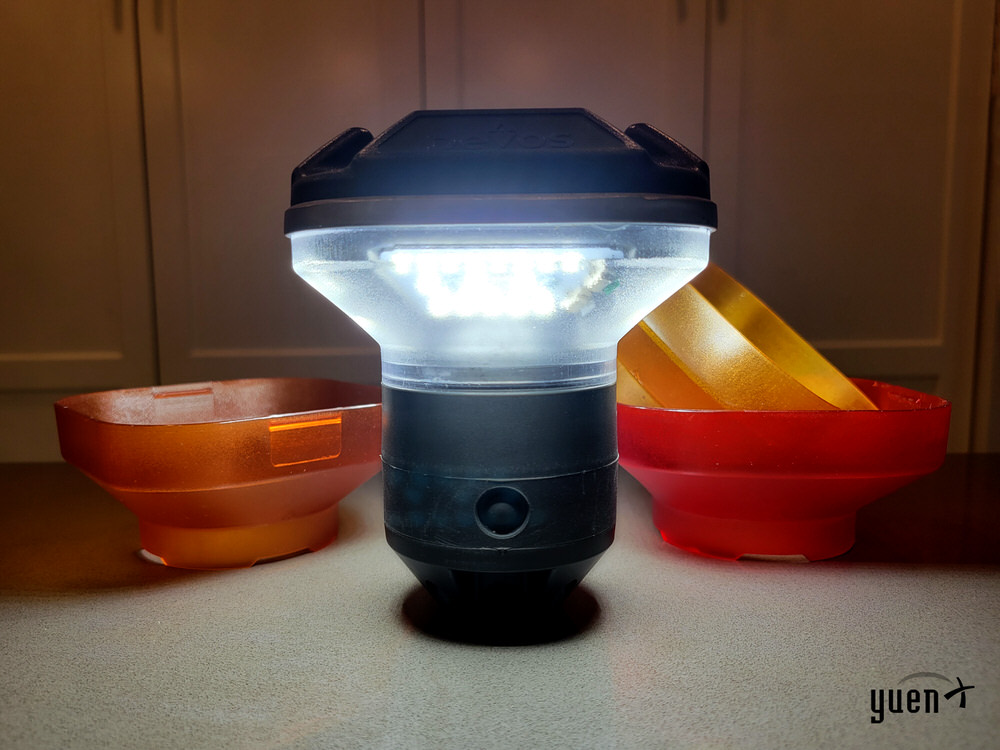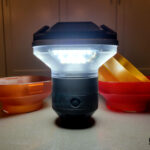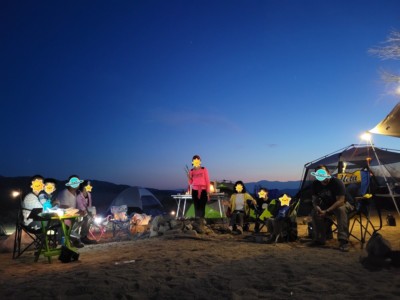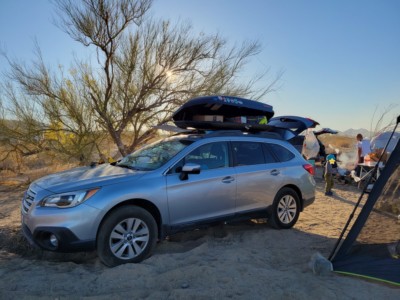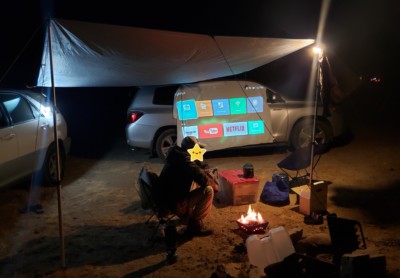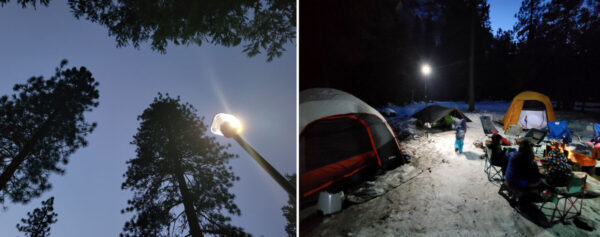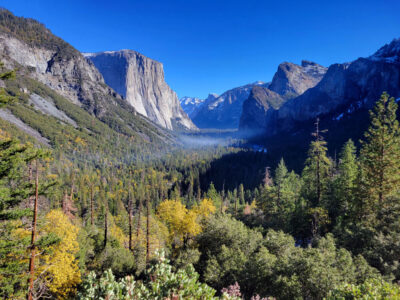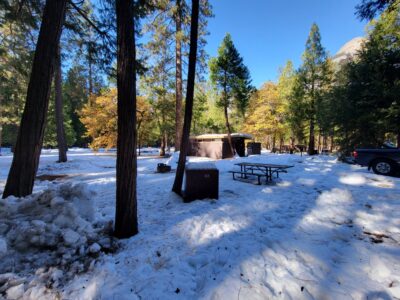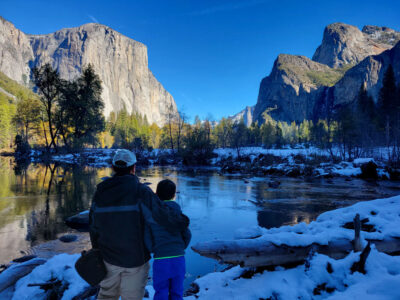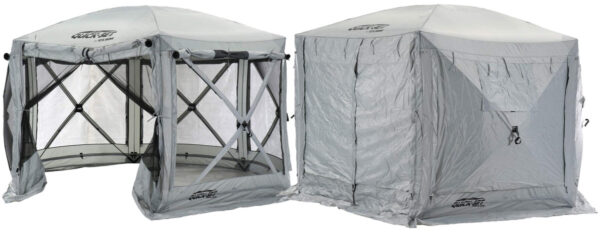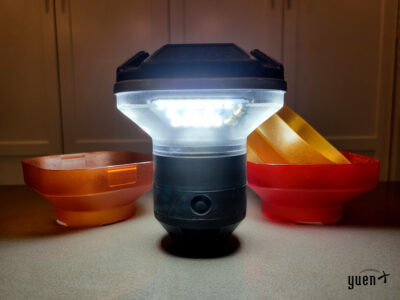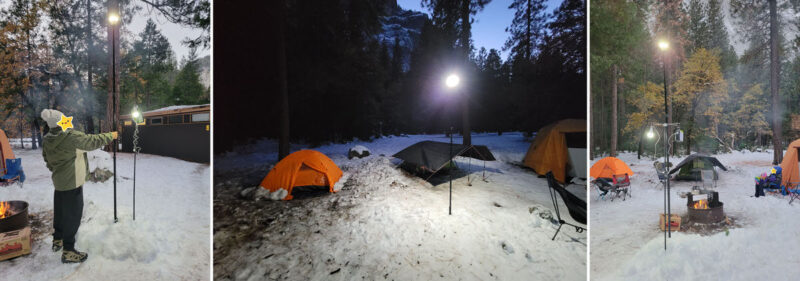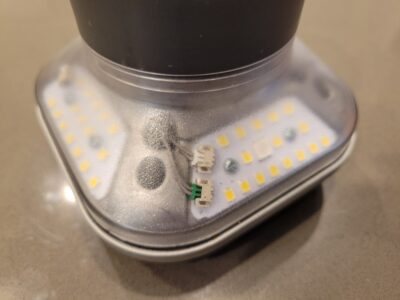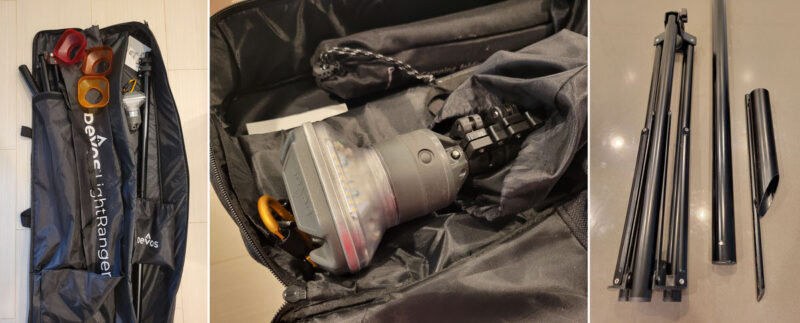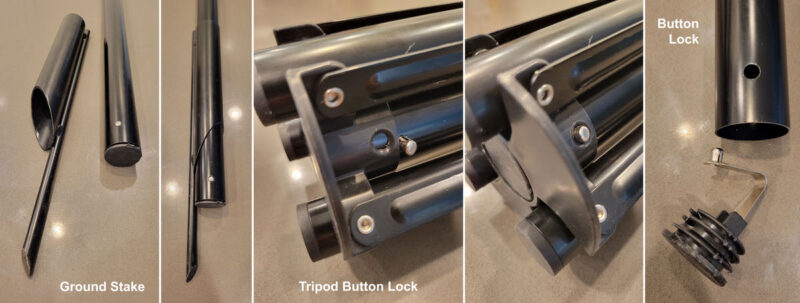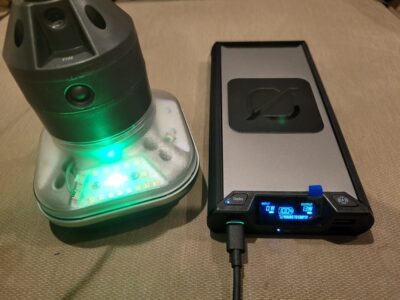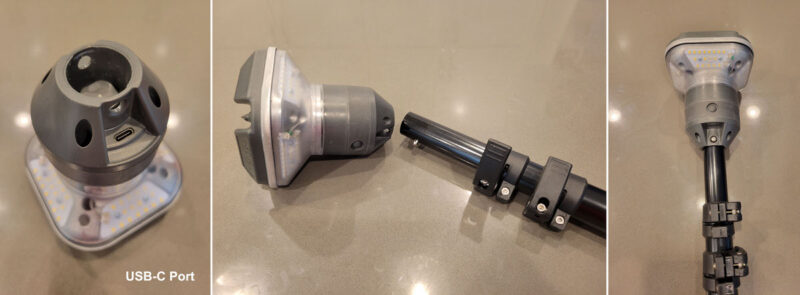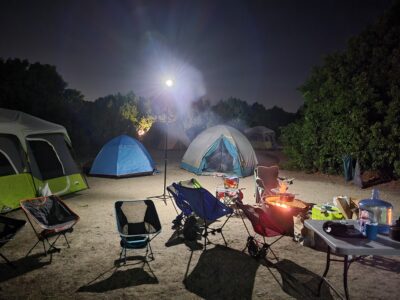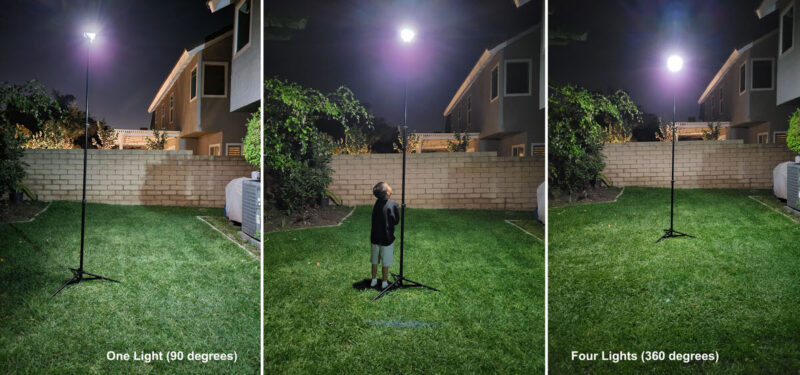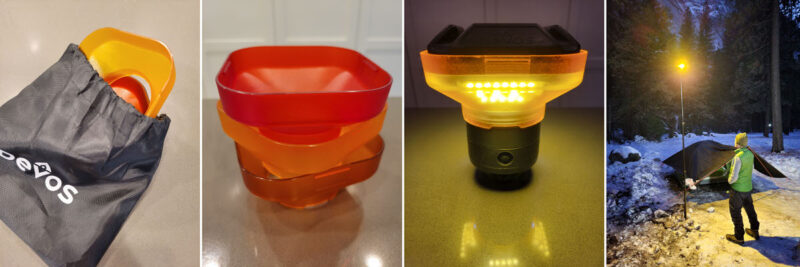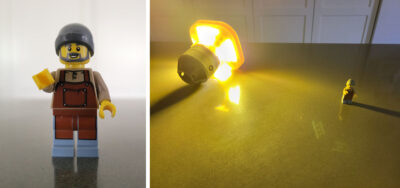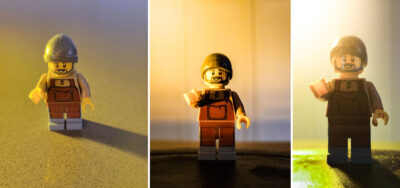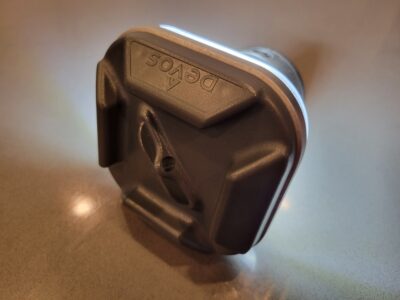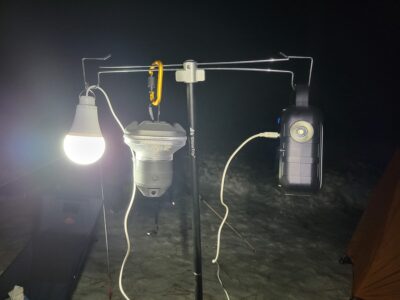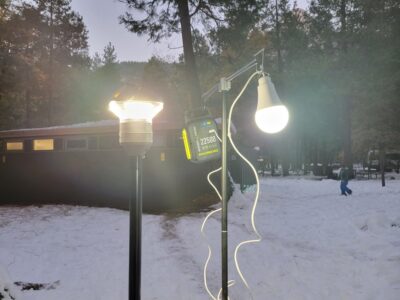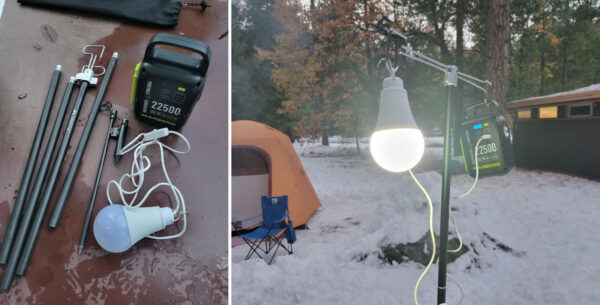Devos LightRanger 1200 Portable Camp Light with Battery
Pros
- Built-in 38.5Wh Battery (4-16 hours)
- Light Intensity & Directional Controls
- Weatherproof, Impact-Resistant
- Very compact. Portable, light
- Telescoping 9' Pole
Cons
- Pricey
- No remote control or RGB color adjustment
- Cannot buy just the lamp
- Pole has no loop attachment
- Button lock mechanism subject to failure
Contents
Let It Shine
Having proper lighting can make a crucial difference between enjoyment and frustration while barbequing in the backyard, camping in the forest, repairing a vehicle, or photographing a scene. If one cannot see well, safety, quality, emotions, and creativity could be negatively affected. As such, I had been collecting and testing a large variety of lights over the past three decades for a range of purposes, including professional wedding photography, outdoor activities, and general home improvement projects.
The factors to look for in a light source are:
- Technology such as LED, laser, fluorescent, and halogen
- Intensity, brightness, and diffusion
- Color temperature
- Energy efficiency and longevity
- Power source like USB battery, solar, gas, or heat
Different use cases have specific requirements. For instance, my family had been enjoying overlanding/boondocking over the last three years where one drives their vehicle into the wilderness and camps without any amenities like toilets, running water, shelter, and lights. The overlander must bring everything they need. We had been using a combination of headlamps, solar lanterns, and USB light bulbs to illuminate our camping spots, but to sufficiently brighten a large area, several of them were required. More friends and families had been joining us and the need for an efficient light source that could cover greater distances had become an increasing need.
From my past photography work, I knew that the higher a light was positioned, the more space it could illuminate underneath. A tree branch- or stand-mounted USB light bulb to cover a large area came to mind – one hung off a carabiner and powered by a battery bank for all-night use. Alas, no weatherproof, elegant solution was available until I came across the Devos LightRanger 1200 last year from a new, Utah-based company. Its feature set looked very promising and interesting, and I bought one for my recent winter camping trip to the beautiful Yosemite National Park with friends and family. The light surprised me.
This article is a review of the Devos LightRanger 1200 and how it compares to my other camping lights:
- Headlamp / Battery Lantern / USB Lightbulb with Power Bank / Propane Lantern
Our latest adventure was camping at Yosemite National Park during Thanksgiving 2022 where two inches of ice and below-freezing temperatures greeted us. That was when we were SO GLAD to have brought our beloved Mr. Heater Buddy to keep us warm. Alternatively, we could have brought the Outland Living Firebowl placed inside a canopy tent with all its sides covered to retain heat. Our favorite canopies are Clam Quick-Set Pavilion and Axa AxplorOutdoor as both come with built-in side covers.
Devos LightRanger
In A Nutshell
The LightRanger 1200 by Devos is a weatherproof lamp with a built-in 38.5Wh battery (Li-ion NMC) rated to last up to 16 hours. What makes it unique is its 1,200-lumen maximum brightness that can cover a ground area of 50+ feet in diameter (25′ from the center) when mounted 8.7′ (104″) high on its telescoping pole. That makes one HECK of an excellent coverage from a small, portable package! It accomplishes that through one simple premise: move the light source up high and project it down and outward for a larger, illuminated circle — like stepping back further while shining a flashlight at a wall to see more of it.
After three months of using the lamp while camping, overlanding/boondocking, barbecuing, and stargazing; for sports (like tennis at night), DIY house projects, and yes, even photography; I will summarize our experience right here: the Devos LightRanger is the BEST portable light with the broadest coverage and versatility we have ever used — all in an elegant, weatherproof package. Period. One cannot appreciate how vital good, reliable lighting is for activities, especially when cooking in the dark, not just for visibility but also safety!
The Devos LightRanger 1200 is the BEST portable light with the broadest coverage and versatility we have ever used — all in an elegant, weatherproof package. Period.
Part of the LightRanger’s attraction includes its ease of use (by not having to haul around multiple lamps and batteries) while managing to stay out of the way and providing control over how it projects the light. There were some shortcomings and areas we would like to see improved, pricing included, but we will go over them during our full analysis below.
[Update 10/12/2023: Goal Zero released its new Skylight with Battery that is worth considering. See our full review!]
Analysis
The LightRanger 1200 has become one of our favorite camping lights for many reasons. One of the features we love that fellow campers had told us they also appreciated is its ability to shine from 1, 2, or 4 sides with a respective projection of 90, 180, or 360 degrees. Furthermore, the light angles DOWN and can have its brightness dimmed to 20% to minimize spill towards the neighboring areas. Color filters (like the Amber one) can help maintain the campfire ambiance.
What that means is that the LightRanger can illuminate an entire area in all directions (360 deg), half the space (180 deg), or just a small section (90 deg) without disturbing the neighbors. That also proved useful for stealth camping or stargazing where we wanted to minimize light pollution and not draw too much attention towards us.
Additionally, having the light source up high sent the annoying bugs away from where we were sitting while at the same time not blind us the way a table-side, eye-level lantern does. Attaching an Amber cover (part of the optional Colored Filter Kit) to the lamp turned the 5,000 Kelvin light (pure white and close to the sun’s 5,780K rating) into a warmer one (approximately 2,200K) that further reduced the number of bugs flying towards it while maintaining visibility for us. It did nothing to protect us from mosquitoes, however, as they are neither deterred nor attracted to light. The Red filter is best for stargazing or night hunting, and the Soft-White produces a warm ambiance.
Hardware Components
The LightRanger included a lamp, telescoping pole, and tripod (each weighing 1lb 5oz); a 13oz steel ground stake, carry bag, and USB-C charging cable for a total of about 5 lbs. A USB wall adapter was not part of the package.
We used the tripod indoors and outdoors on hard or sandy surfaces, and the ground stake on dirt, grass, and even snow or ice. A pole connects to either the tripod or stake and is secured to the former with a quick-release button at its base. There is no locking mechanism for the stake, however. From there, quick-release clamps allow the pole to adjust its height from between 39″ to 104″ (8.7′), and the lamp is connected at the top with the same button method.
Regarding the button locking technique… The implementation keeps the lamp securely attached to the pole. That is important when considering that a hefty object is raised 9′ off the ground and could become a potential source of injury if it were to fall on someone’s head. However, button locks are bound to fail when its spring weakens over time or gets dislodged. That actually happened to me and Devos sent a replacement free of charge along with a video on how to easily re-install yourself.
I sometimes wished, however, that Devos replaced the button design with a 1/4″ screw mount instead that is commonly found on camera tripods. That would provide greater flexibility for use with third-party mounting hardware. For instance, a ball head mount would allow the lantern to be oriented at an angle for diagonal projection up a tree. Blame my photography days and Manfrotto tripods for that little yearning ;-) A screw mount would also allow for attachment to a paddleboard or helmet like a GoPro for nighttime visibility and safety. The downsides to such a setup would be increased material cost, and the extra time it would take to fasten or unscrew the lantern.
Tip: Keep the lamp attached to the pole and inside the carry bag for better protection. Total length: 43″ (39″ pole, 4″ grooved lamp).
The ground stake looks strong enough to withstand strong winds, and if the tripod is used instead, I suggest weighing the legs down with heavy things like sandbags or backpacks.
Lamp
The detachable lamp is 5.25″ x 4.5″ x 4.5″ and has a built-in grommet at the top for looping a rope or carabiner through. This allowed us to hang it off our backpack; a tree, tent, or awning for when we were too lazy (or restricted) to take out the pole; and even used it as a guiding light during a night kayaking session inside a California harbor. Its ABS plastic body and polycarbonate lens make it quite impact resistant, but caution should still be exercised to minimize risk of damage. Polycarbonate is a key ingredient of bulletproof glass, but don’t drop it onto concrete from a tall building, okay? The material Devos used lends to the lantern’s IPX6 rating: can resist high-pressure, heavy sprays of water. Technically, many IPX6 products could briefly be dunked in water, but it is best to have a fully waterproof and dustproof rating before submerging — like at least an IP67 or IPX7. Yes, I have taken the lamp paddleboarding, but it was probably a stupid thing to do.
I would like to see a future accessory to magnetically attach the Devos to the side of a car to expand where the lamp could be mounted and used without a pole or carabiner.
Need extra lamp? At the time of this writing, a standalone lamp cannot be purchased without the included accessories.
Battery
Housed within the LightRanger is a Li-ion NMC battery (10,400 mAh @ 3.7V = 38.5Wh) that Devos claims to last 3.5+ hours on High (1,200 lumens) and 16+ hours on Low (30 lumens). I did not get a chance to test those numbers, but one can induce the following with the below formula:
- Calc: Hours available for device = Battery capacity (Wh) x 0.85 / Watts used by device
- 10-15% of power is lost during power conversion
- Low Setting: 2.05W = 38.5 Wh x 0.85 / 16 hours
- High Setting: 9.35W = 38.5 Wh x 0.85 / 3.5 hours
So, the light sips a mere 2.1W+ on Low and 9.4W+ on High.
Behind the clear lens by the power button is the battery level indicator: Red 0-33% / Yellow 34-66% / Green Blink 67-95% / Solid Green 100%. Devos claims a full charge from empty in as fast as 4 hours via its USB-C port (5V @ 3A, 18W max). Although I did not test, that sounds right. The LightRanger is described to reach 60%+ within the 1st hour, then to full within the next 3 hours. Today’s batteries do not fast-charge throughout the entire time. Instead, they only go fast until around 60-80%, then increasingly slow down until full. A 38.5Wh battery could be recharged between 3-4 hours at 18W.
Devos wisely replaced the original micro-USB port with USB-C on my revised lamp that can now be used to charge faster at up to 18W (5V @ 3A). It can also recharge other devices at up to 8.88W (3.7V @ 2.4A).
- Input: LightRanger accepts a charge from an optional wall or car adapter and could also utilize a solar panel for as long as the maximum voltage (5V) and amperage (3A) is not exceeded. Some panels have built-in circuitry to prevent overloading, but Devos sells its own 10W, 20W, and 30W Solar Panels with LightRanger Receiver
- Lamp can be used while charging, though the battery level indicator does not turn on until unplugged
- Although the company sells its own solar panels, if you already have one that can output USB, you won’t need to buy one from Devos
- At $80 – $200 (depending on panel capacity), I would rather use that money to buy power banks or a power station although you will have to weatherproof them. But at least they will work better in the rain than solar panels
- I kept the battery charged with an Anker or Goal Zero Sherpa power bank that was secured at the top of the pole with Velcro, or with a power station from Goal Zero, EcoFlow, Jackery, or other brand
- Output: Other devices, like a smartphone, could be fast-charged at up to 8.8W in a pinch
- I advise against it. The LightRanger is too expensive to be used as a power bank. Just buy one of the Ankers or Goal Zeros instead
As I had mentioned, the battery is made up of Li-ion NMC. That chemistry loses about 20-25% of total capacity after every 500 charge cycle. What that means is that after the first 500 cycles, the battery drops 20% from 38.5Wh (when it was new) to 30.8Wh, then to 24.6Wh after the next 500 cycles, and 19.7Wh after that one. It would take roughly 1,500 charging cycles to have the battery last only half as long as when it was brand-new. In theory, it should be usable for 2,000+ cycles or about 6-10 years. The battery is not user replaceable without breaking the warranty.
CAUTION: Lithium-ion (LiFePO4 and NMC) batteries do NOT like to remain discharged at 0% for prolonged periods of time. If you let your battery stay at 0% for too long, you may not be able to charge it again without specialized equipment.
Keep the battery charged at between 20-80% (Yellow power level indicator) while in storage to maximize its lifetime. Li-ion NMC can be used in temperatures between -4F and 140F.
Air Travel
Both the TSA and FAA allow for batteries up to 100Wh to be carried or checked (certain rules apply) onto an airplane. Batteries between 101-160Wh were also accepted as of January 2023 subject to additional restrictions. The lamp’s 38.5Wh capacity falls well within those requirements. However, each airline may have its own rules although both United and Southwest Airlines started matching the TSA/FAA. Lithium-ion batteries are known to be volatile, and the higher their capacity the riskier they are.
Light Intensity, Direction, Color
The power button is used to control both the light intensity and direction.
- Direction: Lamp turns on with all four lights, then two, one, and off with each subsequent, short push. Wait 2 seconds and push again to turn off from any state
- Each light illuminates a 90-degree field: 90 with one light (1 direction), 180 with two (2 directions), 360 with all four (4 directions)
- Allows one to direct the light to a specific area that needs it
- Intensity: Lamp turns on at the highest brightness, and holding the button smoothly cycles to the lowest brightness level (20%) and back
- Because of the smooth cycling, it makes it difficult to know when exactly the lowest level has been reached. By the time I do, it has already creeped back up towards high
- Lower intensity level increases the battery runtime
Take note that the LightRanger always turns on with all 4 lights and at their highest brightness level. It does not remember the last setting used.
Tip: Long-press the power button to check the battery level.
The lamp can be flipped upside down to illuminate upwards for use cases that include working underneath the car, lighting up the ceiling of a cave, or creating a scary ambiance for telling horror stories by the campfire. It unfortunately cannot be used as a strobe or Emergency (SOS) distress signal. Devos, could you add that feature to the short-press cycle?
Color Modification
Devos sells an optional Colored Filter Kit to adjust the light and mood for different situations. It includes Red, Amber, and Soft-White that turn the 5,000 Kelvin lamp (pure white close to the sun’s 5,780K) to softer, warmer temperatures. The below are the approximate Kelvin values for each filter and what they are commonly used for in photography/videography and the outdoors:
- Soft-White (3,000K)
- Outdoors: Provides a soft, warm ambiance and maintains good visibility around camp
- Photography: Adds cheerfulness and warmth akin to a sunset. Skin appears smoother. In my past photography career, I had used it to simulate sunsets during the daytime. More on that shortly
- Amber (2,200K)
- Outdoors: Lowest point in the White light range before turning Yellow. Outputs much warmer ambiance than Soft-White and is similar to sunset orange. Minimizes (but does not eliminate) the number of bugs flying towards the light while maintaining decent visibility
- Photography: Adds cheerfulness and greater warmth reminiscent to after sundown
- Red (1,000K)
- Outdoors: Minimal light pollution. For astronomy and stealth (such as hunting and fishing)
- Photography: Brings feelings of passion to photos. Allows for cleaner astrophotography
Consideration should be made that raising the LightRanger up 9′ into the air would keep most bugs away from your face as they would be swarming above you. Attach an Amber or Soft-White filter to provide both a warm atmosphere and further minimize the number of bugs attracted to the lamp. The filters do little to keep mosquitoes away from you, but your camp neighbors would appreciate the lower light intensity from blinding them or ruining their ambiance. Courtesy is always welcome :-)
Color filters are great to turn existing lighting into different temperatures, but it would have been nicer if the lights themselves could be cycled through any number of RGB color combinations with a remote control. On the plus side, the color filters can easily be cleaned of bugs and dirt as needed.
Sunset Simulation
Just for fun, I wanted to see whether the LightRanger was bright enough to simulate a sunset with the Soft-White filter attached. It would be close to Full CTO at 2,900K (similar to incandescent light bulbs) — the temperature used for photographing portraits at sunset. Color Temperature Orange (CTO) is the term used for gelled lighting that reduces daylight light sources (5,500K) down to the warm 2,900 – 4,500K temperature range. For privacy reasons, however, I am not sharing any samples of my past sunset-simulated photography assignments (shot with a combination of Canon EOS DSLR camera, Speedlite flashes, and MagMod gels), but here is one of a Lego minifigure (snapped with a Samsung smartphone) on the counter of a darkened kitchen:
You may also refer to this YouTube video by one of my favorite photography educators, Pye Jirsa (Lin & Jirsa, SLR Lounge), on how CTO can be used to simulate the “Golden Hour”. Although there is potential for the LightRanger to be used for portrait photography, it would not be at the same level as professional equipment designed for photography and videography. But hey, if you already have the Devos around while camping, it is a viable option to a certain degree.
Pricing
The Devos LightRanger 1200 is expensive. Until it can be mass-produced to bring prices down, there just is no better alternative for portable, compact, weatherproof lighting with as broad a coverage and versatile usage as the LightRanger. There is nothing like it at the time of this writing, but if you know of another product that is as sleek, let me know!
The company offers a discount for Military and First Responders: as much as 10%. Whether that stacks with any existing promotions, I do not know.
Additional Areas for Improvement
Our family and friends love the LightRanger 1200, but it is by no means perfect. Some features we would like the company to incorporate or improve upon:
- Remote Control to adjust the light direction and intensity without having to lower the pole. Perhaps via the Bluetooth Low Energy (BLE) protocol
- Ground Stake Lock — weather via the existing button design or other methods — to keep the pole from easily sliding in or out of the stake
- Magnetic Base to allow the LightRanger to be attached to metal or a car’s body for emergency signaling or lighting. This would allow the lamp to be quickly affixed to the top of an RV without having to take out the tripod and pole
- GoPro Mount Compatibility so the lamp could be attached to the same places as the popular GoPro action cameras. For example, on top of a helmet for 360-degree lighting or a standup paddleboard/canoe for nighttime safety or fishing
- Clear Diffuser Filter to soften the harsh, white light for more flattering photography or videography
- RGB Colors. Instead of using physical color filters to change the temperature of the lamp, it would have been nicer if the lights themselves could be cycled through any number of RGB color combinations with a remote control
- Ability to choose from hundreds of colors provides flexibility for different use cases, including rainbow-colored club lighting during July 4th or New Year’s celebrations ;) Just be sure to be considerate to your neighbors, please!
- On the plus side, the color filters can easily be cleaned of bugs and dirt as needed
- Loop Attachment near the top of the pole from which a battery bank could be hung for longer runtimes
- A workaround is to use Velcro to secure the external power bank to above the height adjustment lever. I used to do that with the Canon Speedlite Battery Packs while photographing weddings throughout the day and night. Be mindful that it could rain overnight and so be sure to weatherproof the battery
- Devos offers a USB-C Work-Light Kit that includes a 10′ cable and 20W USB-C PD AC adapter so the pole could remain fully extended at 9′ while allowing the lamp to be charged from a ground level power source
- I feel the kit should have been included with the core product, but you can buy yourself better options for the same price or less: Anker USB-C PD wall charger with 10′ USB-C cable.
- Motion and/or Dusk-to-Dawn Sensor to additionally conserve battery power
- Automatically turn on when motion is detect to help with going to the bathroom or to alert on the presence of an animal, such as a bear, who may have snuck into camp
Who is Devos?
According to the company’s website, Devos stands for “Developing outdoor solutions for the backyard [and] the backlands” with a mission to “helping customers create hassle-free outdoor experiences”. It is headquartered in Springville, Utah, and just 30 miles south of one of my favorite power station brands: Goal Zero. The company appears to have been founded in 2020 based on WHOIS records for the devosoutdoor.com domain and LinkedIn employee profiles.
Competitors
I had previously mentioned that there is nothing like the LightRanger, and that it is the “BEST portable light with the broadest coverage and versatility we have ever used — all in an elegant, weatherproof package. Period.” What are the alternatives besides the traditional LED or propane camp lights? Are there any that can be raised up high to illuminate a large area? Before I made my decision to buy the Devos LightRanger, I had considered the following:
Light Stands
- Goal Zero Skylight (Goal Zero | Amazon) – See our Review. [Added to this list on October 2023]
- Pros: Expands 12′ up, heavy-duty, VERY bright (can nearly light up an entire soccer field), built-in 33Wh Li-ion NMC battery
- Cons: Pricey, heavy (14 lbs), bulky
- OVS UFO Solar Light and Speaker by Overland Vehicle Systems
- Pros: Expands 7.5′ up, main light has built-in 38.5Wh Li-ion NMC battery (10,400 mAh @ 3.7V) and can be augmented with 3x D batteries, solar panel built-in (Watts rating not specified by OVS), 3 removable pod lights (flashlights) with 6.7Wh battery each, detachable 5W Bluetooth speaker with 4.1Wh battery
- Cons: Not waterproof, pricey, bulky head unit, heavy (12.7 lbs), no remote control
- Thank you for suggesting this light, “Muhl DE EL” (fellow member of the SoCal Outdoorsmen Facebook community)
- SeeDevil Work Light with Remote
- Pros: Extends 6.9′ up, is super bright, provides 360-degree illumination, can be remotely controlled, lamp is inflatable, and is weatherproof
- Cons: Very expensive, has no built-in battery (requires an external power source that can output 65W), cannot control its light direction, inflatable lamp may not last, and is heavy (13.1 lbs). The higher models require even more power and get significantly heavier
- Conpex Five-Panel Camping Light with Remote
- Pros: Extends 11.5′ up, is super bright, and can be remotely controlled
- Cons: Not waterproof, has no built-in battery (requires an external power source that can output a whopping 110W), cannot choose which panels to keep on or off to control direction of light, and has questionable build quality/longevity
- CMrtew Rod Light with Remote
- Pros: Extends 12′ up, is weatherproof and bright, can be remotely controlled, and is inexpensive
- Cons: Has no built-in battery (requires an external power source that can output 48W), is of questionable build quality/longevity, and cannot provide 360-degree coverage
None (but the Goal Zero Skylight and OVS UFO Solar) had a built-in battery and lacked the build quality, compactness, and feature set of the LightRanger or Skylight.
USB Lightbulb with Power Bank
Before the Devos LightRanger, this was my favorite combination to light up the camp:
- USB Lightbulb: Onite / Powkey
- Lantern Pole: TooCust / Other poles
- Power Bank: Anker / Goal Zero Sherpa
The setup was not weatherproof, but certainly provided plenty of lighting around camp for about half the cost of the Devos or Goal Zero Skylight. But, they do not provide the feature set of the LightRanger or Skylight.
Headlamps and Lanterns
I have plenty of these in my camping arsenal. They are either worn on the head (headlamps) or sit somewhere on a table (lanterns) and do not provide the campsite with full-coverage lighting. Bugs love flying towards the light (and into our faces) while we are trying to have a conversation or eat dinner. Propane lanterns do kill bugs instantly and have the added benefit of outputting some heat. None provide the feature set of the LightRanger or Goal Zero Skylight, including Goal Zero’s older lights & lanterns, surprisingly.
Final Thoughts
The Devos LightRanger 1200 is the BEST portable light with the broadest coverage and versatility we have ever used — all in an elegant, weatherproof, but expensive package. Period. There is nothing like it! It has become our go-to choice for illuminating an entire area quickly and safely. We hope that the company can mass-produce them so we could more affordably purchase one or two more to fully light up a tennis or volleyball court or park. In a pinch, we could also use them for constant lighting at wedding receptions…
[Update 10/12/2023: Goal Zero released its new Skylight with Battery that is worth considering. See our full review!]
Where To Buy
- Devos LightRanger 1200
- Solar Panels with LightRanger Receiver
- USB-C Work-Light Kit
- Better option: Anker USB-C PD wall charger with 10′ USB-C cable
- Colored Filter Kit
- Battery Banks
- Velcro for attaching battery to LightRanger pole
- Other Lights
- Heaters
- Canopy Tent with Side Panels
- Built-in Panels: Clam Quick-Set Pavilion / Axa AxplorOutdoor
- Separate Panels: MasterCanopy + five panels (not available for door)
- Other Items
Related Posts
- Goal Zero Skylight: Heavy-duty, bright, portable, full-coverage area light with battery and stand
- Temperature Control
- Mr. Heater Buddy Indoor-Safe Portable Propane Radiant Heater
- Outland Living Firebowl Propane Fire Pit (893 Deluxe) with Refillable Tank
- EcoFlow Wave Portable Air Conditioner
- Cooking
- ICECO 15.7″ Foldable Charcoal Grill – Compact for Tabletop
- Tomshoo vs Solo Stove Camping Stove
- Osba 1L Travel Rice Cooker 12V (2-4 Cups) For Cars (CFXBOB-MR C2)
- Backcountry Meals: RightOnTrek / Mountain House
- Power Stations / Solar Panels / Car Freezers

